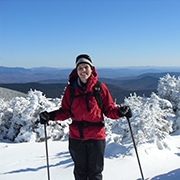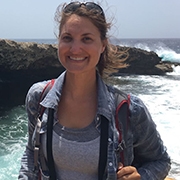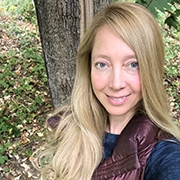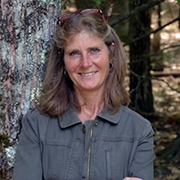Hubbard Brook's Featured Speakers provide interested groups the opportunity to host a Hubbard Brook scientist for a speaking engagement. Read more about the available topics below, and please note home locations when considering a speaker. To inquire about a scientist's availability, please email communications@hubbardbrookfoundation.org.
Hubbard Brook's Zoom-a-Scientist program enables scientists to join your elementary, middle, or high school classroom via Zoom for a 45 to 60-minute presentation and discussion about their research at the Hubbard Brook Experimental Forest in North Woodstock, NH. To set up a session, please email bleonardi@hubbardbrookfoundation.org.
Featured Speakers
 Scott Bailey
Scott Bailey
Geologist, U.S. Forest Service
Home Location: Woodstock, NH
Scott Bailey is stationed at Hubbard Brook as the Forest Service's lead scientist for this experimental forest. By elementary school, he was filling his pockets with rocks and digging underground forts in the backyard. These activities grew into a scientific interest in geology, and especially in the processes by which rocks interact with water to breakdown and form soil. He received a B.S. in geology from the University of Massachusetts, an M. S. in hydrology from the University of New Hampshire, and a Ph.D. in geology from Syracuse University. In addition to his soil and water research at Hubbard Brook, he has studied sugar maple decline and geologic factors controlling the distribution of plants, from Pennsylvania to northern Quebec. He is also the co-founder of the Northeastern Soil Monitoring Cooperative.
Topic: An Acid Rain Retrospective: From Discovery to Controversy and Beyond
Before the recognition of human-caused climate change, acid rain was one of the most complex, widespread, and controversial environmental issues to be tackled by the scientific and public policy communities. This talk summarizes the discovery of acid rain in North America at the Hubbard Brook Experimental Forest, New Hampshire, and the subsequent controversy over its effects on forests. It was in this setting that Dr. Bailey's career started as a graduate student researcher. Trained as a hydrologist and geochemist, he quickly learned to collaborate with pathologists and physiologists interested in the health of organisms from brook trout to sugar maples. As we navigate real and imagined controversies about the science of climate change and society's response, looking back at the lessons learned from acid rain may provide valuable perspective.
Topic: Seeing the Forest for the Streams
Although headwater streams comprise the majority of stream miles in a river basin, they are incompletely inventoried and poorly understood. New research at the Hubbard Brook Experimental Forest, New Hampshire, uses the emerging perspective of hydropedology - a discipline that combines soil science and hydrology - to reveal how forests, soils, and streams are interconnected. Dr. Bailey and colleagues are tackling questions such as: What happens to rain after it seeps into the ground, and how does it get to streams? How does the forest regulate water quality and provide clean, reliable water supplies that sustain major population centers in the northeastern United States? This talk highlights the latest findings from Hubbard Brook, with implications for our understanding of forest soil fertility and the health of our aquatic resources.

Alix Contosta
Research Assistant Professor, University of New Hampshire
Home Location: Durham, NH
Dr. Alix Contosta is a Research Assistant Professor at the University of New Hampshire's Earth Systems Research Center. She explores interactions between land use and climate, with emphasis on carbon sequestration and greenhouse gas emissions from ecosystems under a variety of land uses and management regimes. She also studies winter ecology and the winter-to-spring transition, especially the ways in which climate change impacts terrestrial ecosystems during these periods. Dr. Contosta utilizes a combination of innovative field and lab experiments, state-of-the-art environmental sensors, and data-model integration to pursue her research agenda.
Topic: Changing winters and their impacts on the Northern Forest
 Sara Kaiser
Sara Kaiser
Research Ecologist, Cornell Lab of Ornithology
Home Location: Ithaca, NY
Sara Kaiser is a Research Ecologist at the Cornell Lab of Ornithology in Ithaca, NY. Kaiser directs the Hubbard Brook Field Ornithology Program - a field-based, student research and training program in avian biology at the Hubbard Brook Experimental Forest in the White Mountains of New Hampshire. She received a Ph.D. from Cornell University in behavioral ecology, an interdisciplinary M.S. from Michigan State University in ecology, evolutionary biology and behavior, and a B.S. from Iowa State University in zoology and genetics. She conducted postdoctoral research at the Cornell Lab of Ornithology, Smithsonian Migratory Bird Center, and Smithsonian Center for Conservation Genomics. Her research focuses on understanding how individuals and bird populations respond to changes in their environment. For many birds, the initial behavioral response is a key component of the species' overall population response. She examines behaviors in their natural context to understand how both the social and ecological environment influences behavior and to link individual mechanisms, including physiology, behavior and genetic variation, to bird population dynamics.
Topic: A Walk in the Woods: A half-century of bird discoveries at the Hubbard Brook Experimental Forest
For over 50 years, the Hubbard Brook Experimental Forest in the White Mountains of New Hampshire has been used extensively for studies of bird populations. Over those years, the forest ecosystem has experienced significant changes in food supplies for birds. Learn about the many discoveries of how food supply affects forest birds at Hubbard Brook and the value of long-term studies for understanding the impact of slow changes in the forest ecosystem on bird populations.
 Anthea Lavallee
Anthea Lavallee
Executive Director, Hubbard Brook Research Foundation
Home Location: Woodstock, VT
Bio: Having worked across a range of environmental and social service organizations over the past two+ decades, Anthea believes that culture and ecosystem health are deeply entwined. As the Executive Director of the Hubbard Brook Research Foundation, the non-profit communications arm of the Hubbard Brook Ecosystem Study, Anthea bridges the gaps between science and society. Within Hubbard Brook and across its network of partners, Anthea works to create a culture of environmental awareness that is scholarly and practical, reality-based and creative.
Topic: The Little Brook that Changed the World: How NH's Hubbard Brook Ecosystem Study Shapes Environmental Policy and Practice, From Acid Rain to Climate Change
As the Executive Director of the Hubbard Brook Research Foundation, Anthea Lavallee has a front row seat for one of the most dynamic and influential ecosystem studies in the world. Established in 1955 by the U.S. Forest Service in the White Mountains of NH, Hubbard Brook brings together scientific teams from more than 25 universities and research institutions. Together they explore the relationships among Hubbard Brook's plants, animals, air, water, and soils. Anthea will share key Hubbard Brook discoveries including acid rain, the impacts of forest cutting on water quality and quantity, and climate change consequences. Long-term ecosystem studies have the power to reveal otherwise imperceptible patterns, trends, irregularities, and environmental solutions. Anthea will make connections between Hubbard Brook research and our economy, ecology, culture, and quality of life as citizens of the Northern Forest.
 Lindsey Rustad
Lindsey Rustad
Team Leader/Research Ecologist, U.S. Forest Service
Home Location: Durham, NH
Lindsey Rustad is a Research Ecologist with the US Forest Service in the Northern Forest Science & Applications unit in Durham, New Hampshire, and the Forest Service Team Lead at the Hubbard Brook Experimental Forest. She received a B.A. in Philosophy from Cornell University, an M.S. in Forest Science from the Yale School of Forestry and Environmental Science, and a Ph.D. in Plant Science from the University of Maine. Her research investigates how human disturbances are impacting the forests of northeastern North America, particularly through climate change and acid deposition. Her approach emphasizes the need for multidisciplinary collaboration in order to understand how ecosystems are responding to global change. Dr. Rustad is also passionate about integrating art and science to share ecological data with a broader audience.
Topic: Freezing Trees: Impacts of Ice Storms on Northern Forests
Ice storms are a major cause of distrubance in the Northeastern US, striking as frequently as every 2-5 years. But these storms are difficult to predict - scientists don't know when or where they will occur next. Despite their influential role in shaping forest ecosystems and the services they provide, knowledge of ice storms remains relatively limited. This talk describes the findings of a new study at the Hubbard Brook Experimental Forest that is using a suite of tools, including creating artificial ice storms, to study the impacts of these storms on northern hardwood forests. This research is providing the scientific community, land managers, and the concerned public greater insight on the effects of these powerful, frightening, and curiously aesthetic extreme winter weather events.
Zoom-a-Scientist
Emily Bernhardt
Professor of Biology, Duke University
Topics:
- Climate change
- The carbon cycle
- Carbon sequestration – what is it?
- Can coal be clean? (https://www.pbs.org/newshour/science/column-clean-coal-mean-can-save-planet)
- Water quality – what does that mean?
- What lives in streams and rivers?
Lynn Christenson
Associate Professor of Biology, Vassar College
Topics:
- Moose (general information)
- Moose (climate-related challenges for animals and ecosystems
- Animals and nutrient cycling/decomposition
Sara Kaiser
Research Ecologist/ Director, Hubbard Brook Field Ornithology Program, Cornell Lab of Ornithology
Topics:
- General topics in avian systems
- Migratory birds
- Reproductive strategies (e.g. mating and parental care)
- Social behavior (e.g. cooperation)
- Migratory bird response to environmental change
- Bird conservation
- Hubbard Brook Field Ornithology Program
- Field methods used to study wild birds
- Conservation genomics
- Sexual selection
- Mating systems
- Temperate vs. tropical life histories
Lindsey Rustad
Research Ecologist, Hubbard Brook Team Leader, USDA Forest Service
Topics:
- Climate Change
- Ice Storms
- WaterViz: Confluence of Art, Music, and Science
- Mysteries of the underground
Audrey Thellman
PhD Student, Biology, Duke University
Topics:
- Climate change and water
- Water quality and ecosystem health
- Land use change (in terms of water), e.g. agricultural runoff
- Winter climate change (lake ice and river ice records)
- Stream ecology
- Linkages between terrestrial ecosystem and streams (seasonality)
Adam Wild
Director of the Uihlein Maple Research Forest, Cornell University
Topics:
- General maple syrup production for beginners
- Flow of maple sap within a tree for maple syrup (physiology and tree anatomy)
- Factors controlling sap sweetness and the importance for maple syrup production (great for discussing photosynthesis)
- Sugarbush management
- Climate and maple syrup production
- Collection of maple sap
- Flavor and grades of maple syrup
- Wound partitioning within maple trees
- Increasing production of maple sap
- Processing sap into syrup
- Microbes and maple sap spoilage
- Other tree syrups: beech and birch
Alex Young
M.S. Forest & Natural Resource Management 2019, SUNY-ESF
Topics:
- Tree canopies
- Leaves
- Ecological forecasting
- Nutrient availability/N and P limitation
- Remote sensing using the NEON AOP
